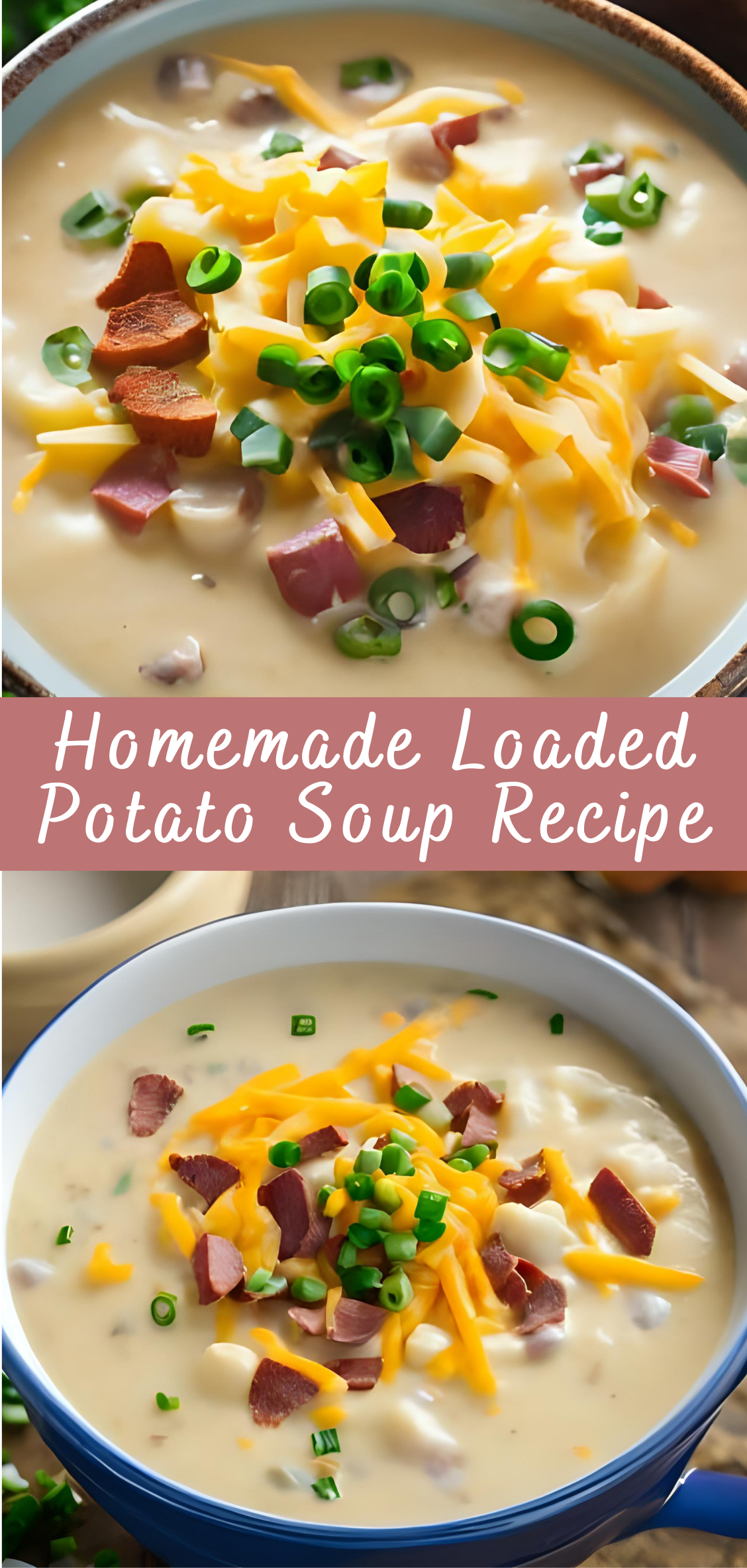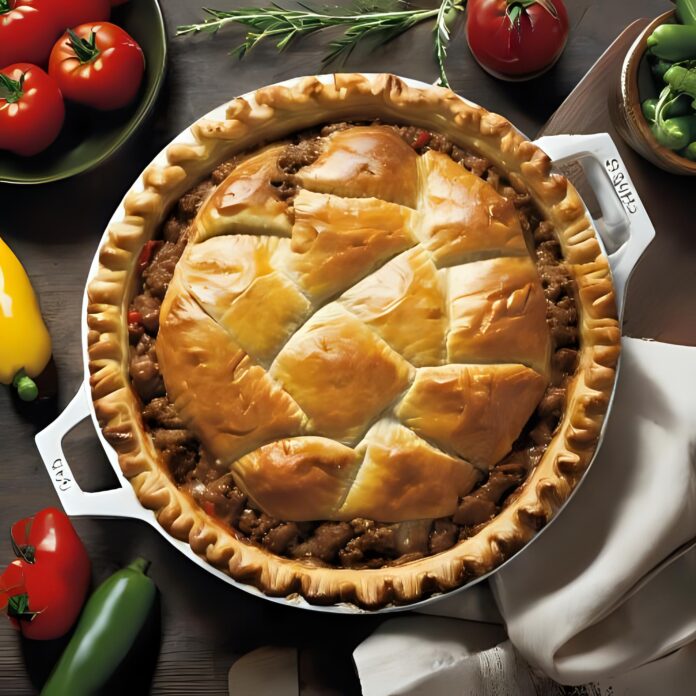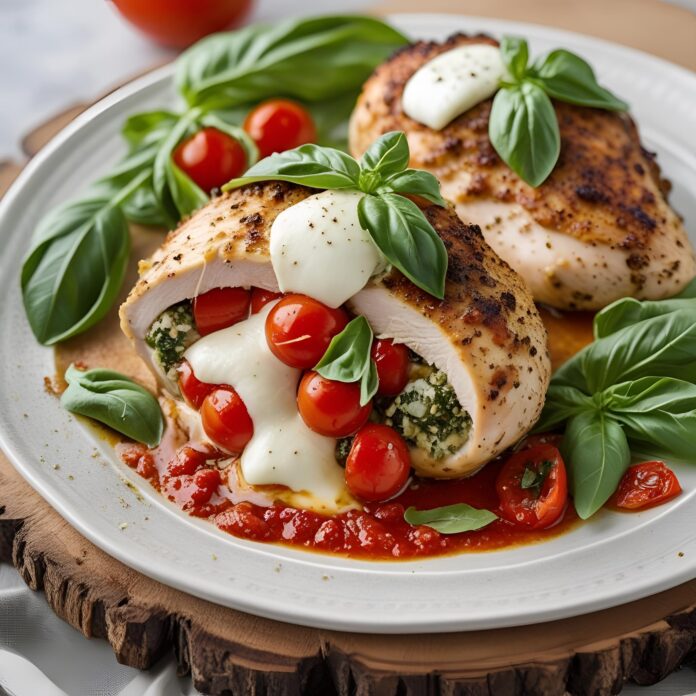Homemade Loaded Potato Soup Recipe
In the wide and wonderful world of comfort food, few dishes deliver the same warmth, heartiness, and satisfaction as a bowl of homemade loaded potato soup. With its creamy base, chunks of tender potatoes, and indulgent toppings like cheese, bacon, and scallions, this soup is a celebration of simplicity elevated to something unforgettable. It’s the kind of meal that doesn’t just fill you up—it soothes you, body and soul.

From rustic farmhouse kitchens to modern city apartments, potato soup has earned its place as a beloved staple across cultures and generations. Its humble beginnings—rooted in necessity, frugality, and homegrown ingredients—have transformed into a dish that’s both nostalgic and endlessly adaptable. The “loaded” version of potato soup adds a luxurious twist to the original, turning pantry staples into a rich, flavorful bowl layered with texture, taste, and satisfaction.
What makes loaded potato soup so universally appealing is its balance between the familiar and the indulgent. At its base, it’s a straightforward dish: potatoes simmered in broth and milk until soft, then blended or mashed into a thick, velvety consistency. But the true magic happens in the details. The creaminess of melted cheddar, the crunch of smoky bacon, the freshness of chives, and the occasional tang of sour cream combine to elevate this dish from simple sustenance to something worthy of a slow, savoring meal.
But don’t let the simplicity fool you—making great potato soup is a culinary craft. Each decision—from the type of potato you choose, to how you build flavor with aromatics, seasonings, and broth, to when and how you add your toppings—can shift the final result. A well-made loaded potato soup isn’t just comforting; it’s a reflection of technique, patience, and care.
This recipe guide is designed not only to walk you through the steps of making a perfect bowl of loaded potato soup, but to teach you how to understand the dish. It’s for home cooks who want to master the basics, as well as for seasoned chefs looking to refine or reimagine an old favorite. Throughout the next several thousand words, we will break down every aspect of this soup—its ingredients, variations, textures, troubleshooting tips, and even creative spins that respect the original while allowing room for innovation.
We’ll explore how to make the most of your ingredients—why Yukon Golds yield creamier results than russets, how bacon can be used in multiple stages for depth, and why building your roux (that mixture of fat and flour that thickens the soup) properly can mean the difference between a soup that sings and one that disappoints. You’ll learn about layering flavors, how to adjust the consistency to your liking, and how to store and reheat leftovers without losing the dish’s soul.
In today’s fast-paced world, where meals are often rushed or processed beyond recognition, the act of making potato soup from scratch feels almost radical. It’s a deliberate slowing-down—a commitment to nourishment, tradition, and the kind of food that invites gathering. Whether you’re feeding a family on a snowy evening, preparing a casual meal for friends, or simply seeking a moment of culinary comfort for yourself, homemade loaded potato soup is a dish that delivers.
This isn’t just a recipe. It’s a lesson in slow cooking, thoughtful layering, and the quiet joy that comes from making something satisfying with your own hands. You’ll come away with more than just a meal—you’ll gain confidence, understanding, and a dish you’ll return to again and again.
Homemade Loaded Potato Soup – Detailed Step-by-Step Instructions
Stage 1: Preparing Your Ingredients
Great soup starts with smart preparation. This stage focuses on selecting and prepping your ingredients so the cooking process is smooth and efficient.
1.1 Choose the Right Potatoes
Type: Yukon Gold or Russet potatoes are ideal.
-
Yukon Gold: Creamy texture and naturally buttery flavor. Keeps shape better—great for a chunkier soup.
-
Russet: Starchier, breaks down more easily—perfect for a smoother, thicker soup.
Instructions:
-
Peel the potatoes (unless you prefer a rustic texture with the skins left on).
-
Rinse under cold water to remove excess starch.
-
Dice into uniform ½-inch cubes for even cooking.
Quantity: About 2 to 2½ pounds of potatoes (roughly 5–6 medium-sized potatoes).
1.2 Prepare the Aromatics and Toppings
-
Onion: 1 large yellow onion, diced finely.
-
Garlic: 3–4 cloves, minced or finely grated.
-
Celery (optional): 2 ribs, finely diced—for added depth and body.
-
Carrots (optional): 1 carrot, peeled and finely diced (adds sweetness and color).
-
Scallions or Chives: Finely chopped, reserved for topping.
-
Cheddar Cheese: Freshly shredded, 1½ to 2 cups.
-
Bacon: 6–8 strips, thick-cut preferred.
1.3 Prep the Dairy and Broth
-
Heavy Cream or Half-and-Half: 1 cup, for richness.
-
Whole Milk: 1–2 cups, depending on desired consistency.
-
Chicken or Vegetable Broth: 4 cups.
-
Sour Cream: ½ cup (optional but classic for tangy creaminess).
-
Butter: 4 tablespoons.
-
Flour: ¼ cup (to create a roux).
Stage 2: Building the Base of the Soup
This stage builds the soup’s body and foundational flavors.
2.1 Cook the Bacon
-
Place a large, heavy-bottomed soup pot or Dutch oven over medium heat.
-
Add chopped bacon or whole strips.
-
Cook slowly, allowing the fat to render, until the bacon is golden brown and crisp (about 8–10 minutes).
-
Use a slotted spoon to remove the bacon and set it on a paper towel-lined plate.
-
Leave about 2 tablespoons of bacon fat in the pot (remove excess if necessary).
Tip: Reserve bacon drippings—this is liquid gold for flavor.
2.2 Sauté the Aromatics
-
In the bacon fat over medium heat, add diced onion and celery (and carrot, if using).
-
Cook until softened and translucent, about 5–7 minutes.
-
Add minced garlic and stir for 30–60 seconds, just until fragrant.
Tip: Don’t rush this step. Sweating the vegetables slowly brings out their sweetness and creates depth.
2.3 Build the Roux
-
Push vegetables to one side of the pot.
-
Add 4 tablespoons of butter to the open space and allow to melt.
-
Sprinkle ¼ cup of flour evenly over the butter.
-
Stir constantly to cook the flour and butter together, forming a light golden roux. This takes about 2–3 minutes.
Why this matters: The roux thickens your soup. Undercooked flour can leave a raw taste; properly cooked roux enhances flavor and texture.
2.4 Add the Liquids
-
Slowly pour in 4 cups of chicken broth, whisking constantly to incorporate the roux smoothly into the liquid.
-
Add in diced potatoes.
-
Bring to a simmer.
Do not boil. A gentle simmer cooks the potatoes evenly without breaking them apart too quickly.
Stage 3: Simmering the Soup
This is where the flavors meld and the potatoes become creamy and tender.
3.1 Cook the Potatoes
-
Simmer uncovered for 15–20 minutes or until potatoes are tender when pierced with a fork.
-
Stir occasionally to prevent sticking.
-
Use a spoon to lightly mash some of the potatoes against the side of the pot to thicken the soup naturally.
-
Leave some potato chunks whole for texture.
Optional: Use an immersion blender for 10–20 seconds if you want a creamier base while still retaining chunks.
3.2 Add the Dairy
-
Reduce heat to low.
-
Slowly stir in 1 cup heavy cream (or half-and-half) and 1 cup whole milk.
-
Simmer gently for 5 minutes, stirring occasionally.
-
Add ½ cup sour cream if using.
Important: Do not boil once dairy is added. High heat can cause separation or curdling.
3.3 Stir in the Cheese
-
Gradually add 1½ to 2 cups of shredded cheddar cheese.
-
Stir until fully melted and incorporated into the soup.
Pro tip: Use freshly shredded cheese from a block for smoother melting. Pre-shredded cheese often contains anti-caking agents that can make the soup grainy.
Stage 4: Seasoning and Finishing Touches
This is the moment to taste, balance, and finalize the soup before serving.
4.1 Season Thoughtfully
-
Add salt and black pepper to taste (start small; bacon and cheese bring plenty of saltiness).
-
Optional spices:
-
Paprika (½ tsp) – for smoky depth.
-
Cayenne pepper (pinch) – for heat.
-
Garlic powder (½ tsp) – for rounder flavor.
-
4.2 Final Texture Check
-
If the soup is too thick: Add a splash of milk or broth and stir.
-
If too thin: Simmer uncovered for 5–10 more minutes or mash more potatoes.
The goal is a rich, spoon-coating consistency without being gluey.
Stage 5: Serving the Soup
Presentation and toppings transform a good soup into a memorable one.
5.1 Prepare Toppings
Have your toppings ready in small bowls for guests to add as desired:
-
Crumbled bacon (from earlier)
-
Extra shredded cheddar cheese
-
Chopped scallions or chives
-
Sour cream
-
Black pepper or red pepper flakes
-
Croutons or buttered toast points (optional)
5.2 Serve Hot
-
Ladle soup into warm bowls.
-
Top generously or let each person customize their own bowl.
-
Serve with crusty bread, biscuits, or garlic toast.
Optional Additions and Variations
Once you master the base recipe, here are some exciting ways to elevate or customize your soup:
-
Add cooked corn or roasted garlic for sweetness and depth.
-
Include sautéed mushrooms for umami and a meatier texture.
-
Swap bacon for pancetta or smoked sausage for a twist on the flavor base.
-
Stir in greens like spinach or kale at the end for nutrition and color.
-
Make it vegetarian by using vegetable broth and omitting bacon—replace with smoked paprika and cheese for savory richness.
Homemade Loaded Potato Soup Recipe
In the wide and wonderful world of comfort food, few dishes deliver the same warmth, heartiness, and satisfaction as a bowl of homemade loaded potato soup. With its creamy base, chunks of tender potatoes, and indulgent toppings like cheese, bacon, and scallions, this soup is a celebration of simplicity elevated to something unforgettable. It’s the kind of meal that doesn’t just fill you up—it soothes you, body and soul.
Ingredients
- 6 slices bacon, chopped
- 1 small onion, diced
- 2 cloves garlic, minced
- 3 tbsp all-purpose flour
- 4 cups chicken broth
- 5 medium russet potatoes, peeled and diced (about 2.5–3 lbs)
- 1 cup milk
- 1 cup heavy cream (or half and half)
- 1/2 cup sour cream
- 1 1/2 cups shredded sharp cheddar cheese
- Salt and pepper, to taste
- 2 green onions, sliced (for garnish)
- Extra shredded cheese and bacon bits for topping (optional)
Instructions
- Cook bacon:
In a large pot or Dutch oven, cook chopped bacon over medium heat until crispy.
Remove bacon with a slotted spoon and set aside. Leave about 2 tablespoons of bacon fat in the pot. - Sauté aromatics:
Add diced onion to the pot with bacon fat. Sauté until soft, about 4–5 minutes.
Stir in garlic and cook for another 1 minute. - Make a roux:
Sprinkle flour over the onions and stir well to combine. Cook for 1–2 minutes to remove the raw flour taste. - Add potatoes and broth:
Gradually whisk in the chicken broth to avoid lumps.
Add diced potatoes. Bring to a boil, then reduce heat to medium-low and simmer for 15–20 minutes, or until potatoes are fork-tender. - Blend (optional):
For a creamier texture, lightly mash some of the potatoes in the pot with a potato masher or blend about 1/3 of the soup using an immersion blender. - Add dairy and cheese:
Stir in milk, heavy cream, sour cream, and shredded cheddar cheese.
Continue to cook over low heat, stirring frequently, until cheese is melted and soup is heated through. - Season and serve:
Add salt and pepper to taste.
Ladle into bowls and top with cooked bacon, extra cheese, green onions, and a dollop of sour cream if desired.
Notes
- Make it vegetarian: Omit the bacon and use butter or olive oil to sauté onions. Use vegetable broth instead of chicken broth.
- Make it thicker: Add more mashed potatoes or a cornstarch slurry (1 tbsp cornstarch mixed with 2 tbsp cold water).
- Add-ins: Corn, chives, or diced ham are great additions.



